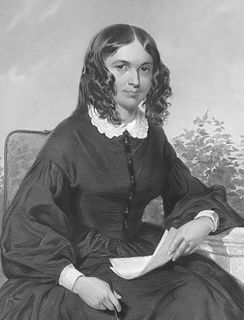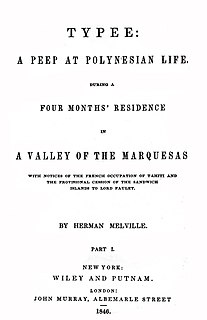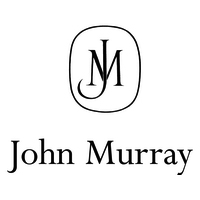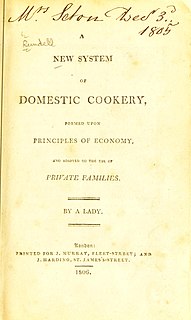
Elizabeth Barrett Browning was an English poet of the Victorian era, popular in Britain and the United States during her lifetime.

Herman Melville was an American novelist, short story writer and poet of the American Renaissance period. Among his best-known works are his magnum opus, Moby-Dick (1851), and Typee (1846), a romantic account of his experiences of Polynesian life.

Typee: A Peep at Polynesian Life is the first book by American writer Herman Melville, published first in London, then New York, in 1846. Considered a classic in travel and adventure literature, the narrative is partly based on the author's actual experiences on the island Nuku Hiva in the South Pacific Marquesas Islands in 1842, liberally supplemented with imaginative reconstruction and adaptation of material from other books. The title comes from the valley of Taipivai, once known as Taipi. Typee was Melville's most popular work during his lifetime; it made him notorious as the "man who lived among the cannibals".

Sir Leslie Stephen was an English author, critic, historian, biographer, and mountaineer, and father of Virginia Woolf and Vanessa Bell.

Omoo: A Narrative of Adventures in the South Seas is the second book by American writer Herman Melville, first published in London in 1847, and a sequel to his first South Sea narrative Typee, also based on the author's experiences in the South Pacific. After leaving the island of Nuku Hiva, the main character ships aboard a whaling vessel that makes its way to Tahiti, after which there is a mutiny and a third of the crew are imprisoned on Tahiti. In 1949, the novel was adapted into the exploitation film Omoo-Omoo, the Shark God.

John Murray is a British publisher, known for the authors it has published in its history, including Jane Austen, Sir Arthur Conan Doyle, Lord Byron, Charles Lyell, Johann Wolfgang von Goethe, Herman Melville, Edward Whymper, Thomas Malthus, and Charles Darwin. Since 2004, it has been owned by conglomerate Lagardère under the Hachette UK brand. Business publisher Nicholas Brealey became an imprint of John Murray in 2015.

Sir Charles Lock Eastlake was an English painter, gallery director, collector and writer of the early 19th century.

Knightshayes Court is a Victorian country house near Tiverton, Devon, England, designed by William Burges for the Heathcoat-Amory family. Nikolaus Pevsner describes it as "an eloquent expression of High Victorian ideals in a country house of moderate size." The house is Grade I listed. The gardens are Grade II* listed in the National Register of Historic Parks and Gardens.

William Burges was an English architect and designer. Among the greatest of the Victorian art-architects, he sought in his work to escape from both nineteenth-century industrialisation and the Neoclassical architectural style and re-establish the architectural and social values of a utopian medieval England. Burges stands within the tradition of the Gothic Revival, his works echoing those of the Pre-Raphaelites and heralding those of the Arts and Crafts movement.

Elizabeth, Lady Eastlake, born Elizabeth Rigby, was a British author, art critic and art historian, and was the first woman to write regularly for the Quarterly Review. She is known not only for her writing but also for her significant role in the London art world.

Anne Isabella, Lady Ritchie, née Thackeray, was an English writer and the eldest daughter of William Makepeace Thackeray. Her several novels were highly regarded in their time and made her a central figure in the late Victorian literary scene. She is best remembered today as the custodian of her father's literary legacy, and for short fiction that places traditional fairy tale narratives in a Victorian milieu. Her 1885 novel Mrs. Dymond contains the earliest English-language use of the proverb "Give a man a fish and you feed him for a day; teach a man to fish and you feed him for life."

Marion Margaret Violet Manners, Duchess of Rutland was a British artist and noblewoman. A granddaughter of the 24th Earl of Crawford, she married Henry Manners in 1882. She was styled the Marchioness of Granby from 1888 to 1906, when Manners succeeded as Duke of Rutland. She had five children, including the 9th Duke of Rutland and the socialite Lady Diana Cooper.

George Gordon Byron, 6th Baron Byron,, known simply as Lord Byron, was an English poet, peer and politician who became a revolutionary in the Greek War of Independence, and is considered one of the leading figures of the Romantic movement. He is regarded as one of the greatest English poets and remains widely read and influential. Among his best-known works are the lengthy narrative poems Don Juan and Childe Harold's Pilgrimage; many of his shorter lyrics in Hebrew Melodies also became popular.

The bibliography of Herman Melville includes magazine articles, book reviews, other occasional writings, and 15 books. Of these, seven books were published between 1846 and 1853, seven more between 1853 and 1891, and one in 1924. Melville was 26 when his first, and had been dead for 33 years when his last, books were published. At the time of his death he was on the verge of completing the manuscript for his first novel in three decades, Billy Budd, and had accumulated several large folders of unpublished verse.
Archibald Campbell Swinton of Kimmerghame FRSE DL LLD, was a Scottish author, politician and professor of civil law at Edinburgh, 1862-72.

Edward Rigby (1747–1821) was an English physician, writer, and local politician.

Ettington Park, Ettington, Warwickshire, England is a 19th-century country house with earlier origins. The historic home of the Shirley family, whose ownership dates from the time of the Domesday Book, the house was remodelled between 1858 and 1862 for Evelyn Shirley. Shirley's architect was John Prichard, although the involvement of Prichard's long-time partner John Pollard Seddon is disputed. The Grade I listed building, described by Chris Pickford and Nikolaus Pevsner as "the most important and impressive High Victorian house in the county", is now a hotel.

Maria Eliza Rundell was an English writer. Little is known about most of her life, but in 1805, when she was over 60, she sent an unedited collection of recipes and household advice to John Murray, of whose family—owners of the John Murray publishing house—she was a friend. She asked for, and expected, no payment or royalties.

Emelia Russell Gurney (1823–1896) was an English activist, patron and benefactor. After her marriage she was generally known as Mrs. Russell Gurney.
Harrison Mosher Hayford was a scholar of American literature, most prominently of Herman Melville, a book-collector, and a textual editor. He taught at Northwestern University from 1942 until his retirement in 1986. He was a leading figure in the post-World War II generation of Melville scholars who mounted the Melville Revival. He was General Editor of the Northwestern-Newberry The Writings of Herman Melville published by Northwestern University Press, which established reliable texts for all of Melville's works by using techniques of textual criticism.